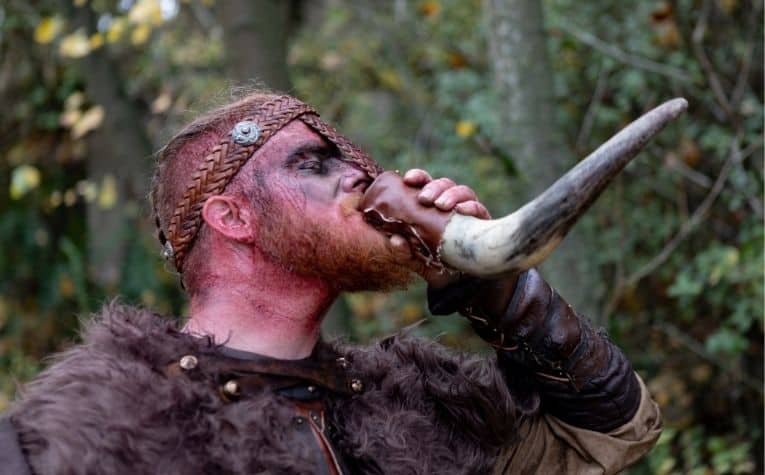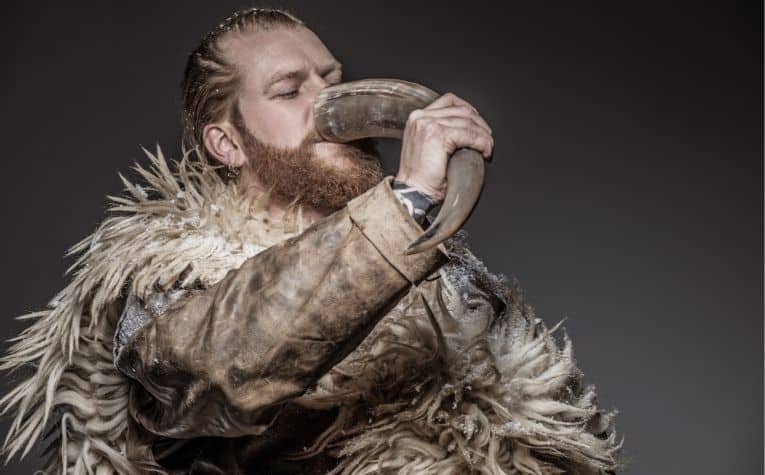The Vikings were a formidable force that sprang out of northern Europe and expanded through sheer aggressive force.
They dominated most of modern-day Europe and beyond during the Middle Ages.
Mead and beer were their alcoholic beverages of choice, but what did the Vikings drink out of?
Vikings often drank out of cattle horns that were fashioned for holding their favorite drinks such as mead and beer.
They often drank from the horns in short amount of time because the base—that is, the tip of the horn—was pointed, not flat. Drink ware in Viking households could have also been from wood or clay.
The Vikings’ way of life fascinates many people. Not only are people interested in the major events, like raids, and in famous warriors, like Ragnar Lodbrok, but a lot of people want to know about the day-to-day life of average Vikings, including household items, like drink ware.
The Vikings were known for raiding, but they had a playful side, too. See Here’s What the Vikings Did for Fun? to learn more.

Different types of drinking vessels?
Drinking horns as well as wooden and clay cups had some variety based on their source and how they were made.
Understanding more details will help people understand more about the Vikings’ drinking vessels:
- Drinking Horns: Horns fashioned for drinking were mainly made from cow and auroch, a type of cattle that went extinct in 17th-century Europe.
- Lathed cups without handles: This type cup was made from lathed hardwood and gripped with the entire hand, rather than just the fingers.
- Cups with handles: This type of cup made from hardwood, but had a handle and was gripped with the fingers.
- Ceramic cups: This type of cup was a form of pottery that was made from treated clay.
- Steatite cups: This type of cup was made from stone.
- Glass beakers: These were the most prestigious vessels due to how they were made and the way of the looked.
A lot of people wonder what the Vikings looked like. See Did the Vikings Paint their Faces? to learn more.

The popularity of drinking horns
Drinking horns were likely the preferred beverage-holding vessels in the Vikings’ culture.
Some families and clans may have reserved their use for special life and community events.
In fact, they were held with such high regard that families would pass them down from one generation to another.
Drinking horns varied from basic animal horns from their cattle to more primitive cones that were made by rolling birch bark fashioned into the shape of a horn.
Drinking horns made of glass were also highly valued and some were imported through trade from other European countries.
Perched at the apex was the prestigious imported glass horn.
Some drinking horns were routinely used as normal drinking vessels, yet others were used only during important ceremonies such as weddings, festivities, and religious rituals.
The Vikings were incredible seafarers. See Here’s Why the Vikings Used Longboats to learn more.
What Did the Vikings Drink?
Water and milk were likely staples of the Vikings’ diet. Scandinavia is surrounded by water and rivers and lakes are numerous inland.
The Vikings’ also commonly owned cattle from which they got milk.
However, alcoholic beverages were the favorite drink of most Vikings. The alcohol of choice was mead and beer.
- Mead was made from fermented honey.
- Beer was made from barley and sometimes flavored with hops.
The Vikings also made and drank other alcoholic drinks.
- One was made from domestic fruits.
- The other was grapefruit wine that was acquired from other European countries. This was considered a luxury wine, mostly consumed by the affluent.

How to make a Viking drinking horn
- Clean the horn by pouring boiling water in it three times or soak in a large pot of boiling water for half an hour. This gets rid of bacteria and the bad smell.
- Melt pure beeswax by placing it in a container inside boiling water. Ensure it is pure and uncontaminated with dangerous additives as the horn will be used for drinking.
- Pour the melted wax into the horns until it builds up a thick layer on the inner lining of the horn.
- Polish the outside of the horn for aesthetics to make it more presentable.
- Let it completely dry for at least a day.
- Make for it a metallic stand to conveniently hold it upright when in use.
- Pour in a drink and enjoy.
Who Were the Vikings?
The Vikings were Scandinavian people from the Middle Ages, who lived in modern-day Norway, Denmark, and Sweden, who were known for their ferocious raiding.
Viking warriors conquered extensive territories throughout the European world.
The Vikings were not only skilled fighters, but determined explorers, who traveled from Baghdad in the Middle East to the eastern coast of North America, nearly 500 years before Christopher Columbus was born.
The Vikings pursued wealth in its various manifestations, whether in portable forms such as silver, gold, and gemstones or in the form of vast lands in which they would settle.
The Vikings spoke the Old Norse language and wrote in runes.
What Were the Major Achievements of the Vikings?
Shipbuilding and seafaring navigation
One of the most remarkable achievements of the Vikings was their shipbuilding technology, which enabled them to travel great distances into uncharted waters.
Their ships were long, sleek wooden vessels that were made with rows of oars and shallow drafts that made them lighter and faster than the other ships that were used at that time.
They could travel in shallow waters and land on beaches more easily.
The Vikings were expert navigators who used a mysterious navigation tool, the “sunstone,” that formed a solar compass that enabled them to identify the sun’s position even on an overcast sky or after dusk.
They leveraged on this innovation to explore distant lands. As a result, they were simultaneously active on four continents.
Trade and Commerce
Although Vikings are reputed for being raiders and warriors, the vast majority were traders and explorers.
Through their advanced navigation skills, they built extensive trade routes and networks spanning all of modern-day Europe, the Middle East, Russia, Northern India, and even China.
They established a merchant market economy where they could sell the wealth they had obtained in their conquests.
Their artisans reworked precious metals such as silver and gold into decorative objects for sale in these markets.
They eventually developed market towns and minted currencies.
Other Viking Achievements
- Viking raiders founded Dublin, the capital city of the Republic of Ireland.
- Some Vikings used potent 2-handed axes in combat that could effortlessly slice through a shield and metal helmet.
- Vikings served as personal guards for some Byzantine Emperors.
- Vikings didn’t wear horned helmets to battle as is commonly assumed.
- Vikings were known for upholding high standards of hygiene bathing at least once a week in hot springs. This was more frequent than other Europeans of that time.
- Vikings used an unusual liquid to start fires, which was made from a mixture of fungus and urine boiled together.
- Prominent Vikings were buried in boats.
- Vikings were actively involved in the slave trade across Europe and the Middle East.
- Some Viking clans operated autonomously and didn’t recognize other Viking groups.
Creativity is part the Vikings’ legacy
The Vikings have gone into the annals of history as a society that significantly shaped the Middle Ages. They could be crude at times, yet they were also a creative and innovative people.
Their iconic drinking horn remains an item of interest a thousand years later, proving their innovative prowess.
You have learned how to make for yourself a Viking-type drinking horn, through a clear guide.
References
- National Museums Scotland; Drinking horns
- Projekt Forlǫg; Drinking Vessels of Viking Norway – Projekt Forlǫg
- Sourcing Innovation; The influence of Vikings on European culture
- History Extra; A Brief History Of The Vikings: Who Were They & Where Did They Come From?
- History.com; 10 Things You May Not Know About the Vikings
- Norse Tradesman; The REAL History of the Viking Drinking Horn,
- Norse Tradesman; What The Vikings REALLY Drank
- Projekt Forlǫg; Drinking Vessels of Viking Norway – Projekt Forlǫg
